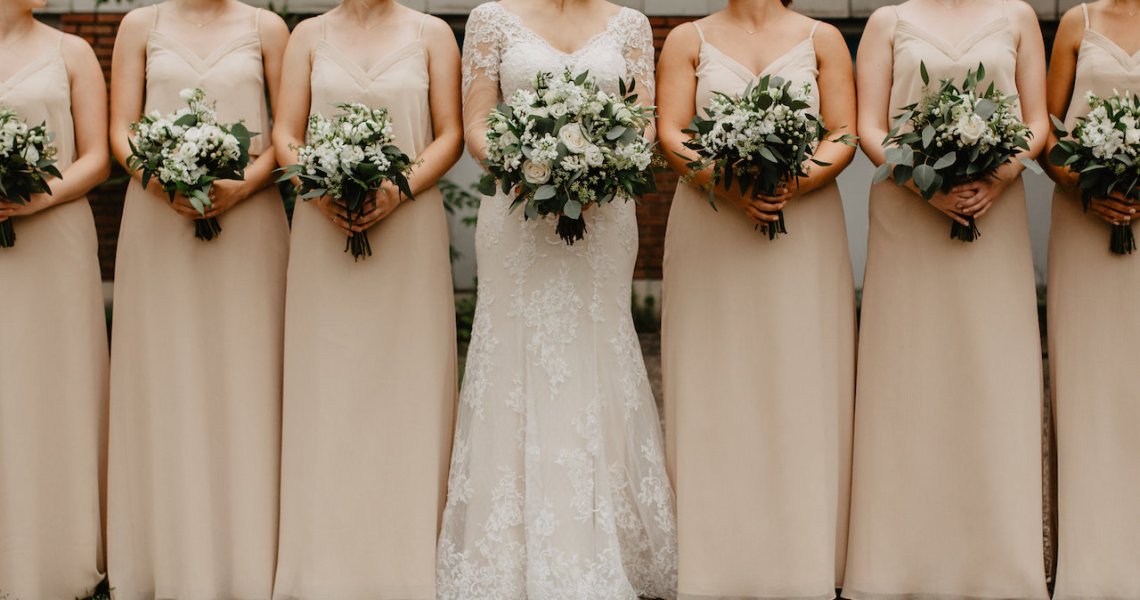Help us learn more about you and your job. Take our short audience survey now for a chance to win a $25 Amazon gift card.
From David’s Bridal bankruptcy filing to the abrupt closure of one of the largest wedding manufacturers, Alfred Angelo, 2018 was a tough year for the bridal market. To younger bridal brands, the challenges faced by their larger counterparts were signals that the market was ripe for change.
“It was interesting for us to see the shift in how things were moving,” said Ranu Coleman, CMO of DTC bridal brand Azazie. “A lot of the bigger brands and smaller boutiques are closing right now, because you have to stay current and keep up with the generations who are making these purchasing decisions. Something that makes bridal so different from other fashion is that we are very referral-based. If someone has a bad experience, everyone will hear about it. I don’t know if that, and keeping up with these changes, was top-of-mind for David’s Bridal.”
For Azazie, which is expanding into several new categories in the next few weeks, the problem with the larger, established bridal brands is that they have been unable to adapt to the new ways people are thinking about their weddings and shopping. In response, the brand has been working on a number of new projects, many of them technologically based, to target the customers who have been turned off by the larger brands.
For example, as of a few months ago, Azazie customers in the same wedding party can gather together in online chatrooms and virtual showrooms on the brand’s website and mobile app, where they can look at dresses together, compare colors and make decisions on what to buy. The intention behind this program is to let bridal parties that are spread out across the country make joint decisions and compare dresses and styles without having to be all in the same location. Azazie can then also observe how customers interact in these chatrooms and what decisions they make, to help the brand strategize and create further improvements to the customer experience in the future.
The goal here is to target younger millennial consumers, who tend to have less money and are more likely to pick a bridal brand based on a referral from friends, according to Coleman, by combining technology with more affordable prices. Azazie’s bridesmaids’ dresses can sell for under $200 and the wedding dresses for under $1,000, and the brand’s average customer is between 18 and 34 years old.
Ad position: web_incontent_pos1
“I would say there is a really big push around personalization and customization of the entire process,” Coleman said. “Because of what has happened to a lot of traditional retail stores in this space, it’s caused everybody to think about creating that personalized experience online to cater to the millennial demographic. That’s what we’re thinking about: How do we recreate a great experience but do it all online? How do we customize everything for her and make everything personalized? That’s the key.”
This approach has served Azazie well. The company said it grew 200% between 2016 and 2017, when it first began experimenting with virtual showrooms, and 300% between 2017 and 2018. Azazie was founded in 2014 and currently does not operate any brick-and-mortar stores. The company sells 1,000 dresses a day and sells to 1 in 10 brides in the U.S., according to Coleman. For marketing, it relies heavily on word-of-mouth and peer-to-peer recommendations. Coleman said Azazie has carefully cultivated a high rating on bridal sites like The Knot and Wedding Wire, as well as general review sites like Google.
In the next few weeks, Azazie is planning to expand to new categories, including children’s, men’s and evening wear, all of which were driven by the feedback of customers in the chatrooms, and during and after purchases. The brand’s customers tend to take about six months from initial discovery to final purchase, so there’s ample time to gather data.
Reinventing bridal
Across the bridal industry, young DTC brands are breaking free from past ways of thinking. This includes brands like Azazie and its counterparts Floravere and Anomalie, and also brands that are not strictly bridal-focused but have recently dipped their toes into the category, like Vrai & Oro’s with its engagement rings. Floravere has heavily integrated Pinterest into its shopping process, as the platform is used by 64% of brides, according to data from Edited.
Even resale has made some headway into the bridal space. Nearly Newlywed, a company that buys and sells lightly used wedding dresses, has tapped into the young consumer mindset around ownership and costs, enough to establish itself among the new generation of bridal brands.
Ad position: web_incontent_pos2
“I think one of the main things we see brides looking for is — I hate to use ‘alternative’ — but non-traditional wedding dresses and experiences,” said Jackie Courtney, CEO of Nearly Newlywed. “Something a little more out-of-the-box, compared to the typical ‘bridal’ shopping experience.”
At the time of its bankruptcy in November, David’s Bridal CEO Scott Key acknowledged the company’s struggles with technology and staying relevant, saying the company would “allocate even more of [its] resources toward making strategic investments in digital technologies.”
The advantage smaller brands have is that they can move much faster than their larger counterparts.
“In general, the bridal industry has been really slow to embrace technology,” Coleman said. “I think there’s still a lot of room for growth and opportunity there. Right now, we are exploring a lot of new ideas around virtual try-on that are still preliminary. Some things work really well for a Sephora or a beauty company, but it can feel a little impersonal in other areas. Because bridal is so personal, we are having conversations about tech that makes things feel personal.”




